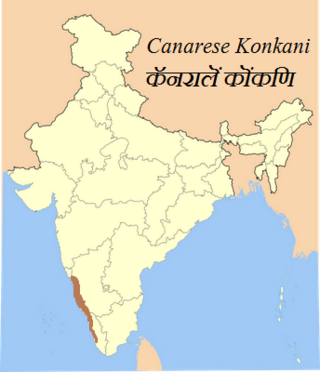
The Dravidian languages are a family of languages spoken by 250 million people, mainly in South India, north-east Sri Lanka, and south-west Pakistan, with pockets elsewhere in South Asia.

The Tulu language is a Dravidian language whose speakers are concentrated in Dakshina Kannada and in the southern part of Udupi of Karnataka in south-western India and also in the northern parts of the Kasaragod district of Kerala. The native speakers of Tulu are referred to as Tuluva or Tulu people and the geographical area is unofficially called Tulu Nadu.
The Kodava is a Dravidian language spoken in Kodagu district (Coorg) in Southern Karnataka, India. It is an endangered language. The term Kodava has two related usages. Firstly, it is the name of the Kodava language and culture followed by a number of communities from Kodagu. Secondly, within the Kodava-speaking communities and region (Kodagu), it is a demonym for the dominant Kodava people. Hence, the Kodava language is not only the primary language of the Kodavas but also of many other castes and tribes in Kodagu. The language has two dialects: Mendele and Kiggat.

Tulu Nadu or Tulunad is a region and a proposed state on the southwestern coast of India. The Tulu people, known as 'Tuluva', speakers of Tulu, a Dravidian language, are the preponderant ethnic group of this region. South Canara, an erstwhile district and a historical area, encompassing the undivided territory of the contemporary Dakshina Kannada and Udupi districts of Karnataka State and Kasaragod district of Kerala state forms the cultural area of the Tuluver.
Arebhashe or Aregannada or Gowda Kannada is a dialect of Kannada mainly by Gowda communities in the region Madikeri, Somwarpet, and Kushalnagar taluks of Kodagu district, Sullia and Puttur taluks of Dakshina Kannada district, As well as Bandadka, Kasaragod District in the Indian state of Kerala. Arebhashe is also called Gowda Kannada. The language was recognized by the Karnataka State government and formed an academy in 2011 to preserve the culture and literature of the Arebhahse Region which is named as Karnataka Arebhashe Samskruthi mathu Sahitya Academy supported by then Chief Minister D. V. Sadananda Gowda.
South Dravidian is one of the four major branches of the Dravidian languages family. It includes the literary languages Tamil, Kannada, Malayalam and Tulu, as well as several non-literary languages such as Badaga, Irula, Kota, Kurumba, Toda and Kodava.
Proto-Dravidian is the linguistic reconstruction of the common ancestor of the Dravidian languages native to the Indian subcontinent. It is thought to have differentiated into Proto-North Dravidian, Proto-Central Dravidian, and Proto-South Dravidian, although the date of diversification is still debated.

Tigalari or Tulu script is a Southern Brahmic script which was used to write Tulu, Kannada, and Sanskrit languages. It was primarily used for writing Vedic texts in Sanskrit. It evolved from the Grantha script.
Tuluva Hebbars are a Tulu-speaking Brahmin community from Karnataka, India. The name "Hebbar" comes from the Kannada, "hebbu/hiridhu" + "haruva".
The Charition mime is a Greek theatre play, in fact more properly to be called a farce or burlesque rather than a mime, which is found in Papyrus Oxyrhynchus 413. The manuscript, which is possibly incomplete, is untitled, and the play's name comes from the name of its protagonist. It is approximately dated to the 2nd century CE, and the play was probably performed in Egypt, where the manuscript was found.

The Beary are a community concentrated along the southwest coast of India, mostly in the Mangalore district of the south Indian state of Karnataka.
The Sholaga (Soliga) language is a Dravidian language related to Kannada and Tamil, spoken by the Soliga people.

The Dravidian peoples, Dravidian-speakers or Dravidians, are a collection of ethnolinguistic groups native to South Asia who speak Dravidian languages. There are around 250 million native speakers of Dravidian languages. Dravidian speakers form the majority of the population of South India and are natively found in India, Pakistan, Afghanistan, Bangladesh, the Maldives, Nepal, Bhutan and Sri Lanka. Dravidian peoples are also present in Singapore, Mauritius, Malaysia, France, South Africa, Myanmar, East Africa, the Caribbean, and the United Arab Emirates through recent migration.

The population of Kerala, India is a heterogenous group that comprises many ethnic groups that originated in other parts of India as well as the world, with distinctive cultural and religious traditions. While the majority of Keralites speak the Malayalam language, various ethnic groups may speak other languages as well.

Tulu Nadu State movement is aimed at increasing Tulu Nadu's influence and political power through the formation of separate Tulu Nadu state from Karnataka and Kerala. Tulu Nadu is a region on the south-western coast of India. It consists of the Dakshina Kannada and Udupi districts of Karnataka and Kasargod district up to the Chandragiri river in Kerala. The Chandragiri River has traditionally been considered a boundary between Tulu Nadu and Kerala from the fourth century AD onwards. The first call for a separate Tulu Nadu state was made just after the Quit India Movement in 1942 by Srinivas Updhyaya Paniyadi, a banker and a press owner from Udupi. Mangalore is the largest and the chief city of Tulu Nadu. Tulu activists have been demanding a separate Tulu Nadu state since the late 2000s, considering language and culture as the basis for their demand.
Karnataka is a state in the southern part of India. It was created on 1 November 1956, with the passing of the States Reorganisation Act. Karnataka is bordered by the Arabian Sea to the west, Goa to the north-west, Maharashtra to the north, Telangana and Andhra Pradesh to the east, Tamil Nadu to the south-east, and Kerala to the south-west. The state covers an area of 74,122 sq mi (191,976 km2), or 5.83% of the total geographical area of India. It comprises 30 districts. Kannada is the official language of Karnataka and as per the 2011 census is the mother tongue of 66.5% of the population. Various ethnic groups with origins in other parts of India have unique customs and use languages at home other than Kannada, adding to the cultural diversity of the state. Significant linguistic minorities in the state in 2011 included speakers of Urdu (10.8%), Telugu (5.8%), Tamil (3.5%), Marathi (3.4%), Hindi (3.2%), Tulu (2.6%), Konkani (1.3%) and Malayalam (1.3%).
Koraga is a Dravidian language spoken by the Koraga people, a Scheduled tribe people of Dakshina Kannada, Karnataka, and Kerala in South West India. The dialect spoken by the Koraga tribe in Kerala, Mudu Koraga, is divergent enough to not be intelligible with Korra Koraga.
Nadu a term used to mean land, country, place, domicile, etc. in the Dravidian languages of southern India, north-east Sri Lanka, and south-west Pakistan..

Canarese Konkani are a set of dialects spoken by minority Konkani people of the Canara sub-region of Karnataka, and also in Kassergode of Kerala that was part of South Canara.
Byari or Beary is a geographically isolated dialect of Malayalam spoken by the Byaris who are part of the Muslim community in Tulu Nadu region of Coastal Karnataka and Northern Kerala. The community is often recognized as Byari s or Byari Muslims. Byari is influenced by Tulu phonology and grammar. Due to the trading role of the community, the language acquired loan words from other languages of Tulu and Arabic sources.









